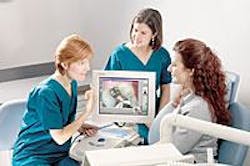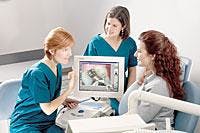The inner circle of restorative
Have you ever thought about the relationship between dentists and lab technicians? With the emergence of tooth-colored, laboratory-processed restorations, smile redesigns, and full-mouth reconstructions, dentists and their trusty lab partners have entered into a complex marriage without the hindrances common to the relationships between doctors and hygienists.
Hygienists have been involved with dentistry since Irene Newman was the first dental hygiene graduate of the Alfred C. Fones School in 1906. Our role primarily has been disease prevention and health promotion. To me, not many areas of dentistry can challenge the importance of a stable periodontium prior to placing definitive restorations. Sometime early in dental history, strife occurred. The strife probably created many of the inconceivable and downright foolish battles between dentists and dental hygienists.
During the past decade or so, the laboratory technician's status has been elevated. Currently, many master ceramists partner with a restorative dentist, and, in some instances, even mentor the doctor on appropriate material selection, prep design, and shade mapping. All of this guidance is welcomed and encouraged. Dentists do not feel threatened by working interdependently with a knowledgeable laboratory specialist. This relationship bears little similarity to the all-too-common paranoia about hygienists working as independent professional partners. The doctors may silently murmur about technicians, but we do not hear or read a constant outcry about the average 6 to 10 percent of gross involved in laboratory costs. In contrast, doctors continually complain about paying hygiene salaries.
Now, the technican and dentist even attend continuing education programs together, improving lab/doctor communication and their working relationship. Usually, hygienists go to one program and the doctors attend another - never shall they meet on common ground. Wow! I want to know how hygienists can get included in this inner restorative circle and further partner with dentists?
As Stephen Covey so eloquently writes, "Seek first to understand, then be understood."
So, short of all hygienists moving to states which allow expanded restorative functions (Arizona, Colorado, Indiana, Kentucky, Ohio, Washington, and Wyoming), we can start by joining (or rejoining) the ADHA and working in our current locations to broaden our opportunities in basic restorative services. We can use states that allow expanded functions as successful models on the road to allowing all hygienists to place, carve, and finish amalgams and/or place and finish composite restorations. When all areas of the United States allow these functions, then the dentist will be able to spend more time providing the artistic dentistry many of them enjoy. In turn, they can have more time to work more closely with their laboratories.
Another option is technology - more specifically, computer-aided design/computer-aided machining (CAD/CAM) restorative systems. CAD/CAM allows chairside ceramic restorations to be machine-milled in the dental office. When restoring teeth, there are traditionally two avenues for restorations - direct and indirect placement.
Direct placement involves a single visit, and the material selection may be a composite or amalgam. Indirect restorations usually require double appointments. Both require client protection protocols, anesthesia, provisional placement and removal, prep clean-up, tray impressions, and time away from the work/life of the client for return visits, etc. The indirect restoration is fabricated in a laboratory. The doctor and laboratory ceramists agree upon the choice of materials, which varies among gold, ceramic, metal, porcelain, etc. With CAD/CAM devices, dental practices can provide single-visit ceramic restorations. An example of this technology is the CEREC 3 by Sirona (www.sirona.com).
With the CEREC system, which was first introduced in 1985, a clinician can design, fabricate, and complete a CEREC all-ceramic crown, veneer, or onlay, all within an hour - from start to finish. The procedure uses an infrared camera to obtain an optical impression. The impression is viewed on a flat-screen color monitor, and the design of the restoration is then accomplished on the CEREC system.
Once the design is finished, a material block is placed in the milling chamber. The milling chamber automatically makes a permanent tooth-colored filling, based on the software-directed designs, without sending it out to a lab. After the removal from the chamber, the restoration is seated for fit, interproximal contact, etc., and adjustments are made. The external aspect of the restoration is smoothed and polished and then bonded into place. This CAD/CAM technology gives the practitioner complete control over all aspects of the design and manufacturing of a restoration.
Sirona hosted a "Practice Integration and Economic Impact" symposium in April. Attendees included practicing dentists and practice management consultants. I was honored to be included. The moderator was Dr. Joe Blaes, editor of Dental Economics. The presenters included the following:
- Stefan Hehn, PhD, provided background about the evolution of the CEREC System.
- Dr. Mark Morin entertained on topics ranging from integrating the system into a practice, to potential clients and fees, as well as core issues about how and why this technology fits in today's practice.
- Dr. Dennis Fasbinder provided clinical information on the quality of CEREC materials, proven technology, and restorations.
- Dr. Charles Blair spoke on the investment required, cash flow, and practice integration.
- Dr. Joel Benk talked about how he recently incorporated the CEREC technology into his practice of 22 years.
The symposium was very educational, especially for me, since I had little knowledge about this technology. I was impressed by the organization and well-presented material covering the evolution of the technology, long-term clinical performance, the high-level of esthetics, and practice management strategies. Among the pearls I learned included the fact that the restorative materials used to mill CAD/CAM restorations come from very familiar and reputable manufacturers, such as Ivoclar Vivadent and 3M ESPE.
In addition, CEREC restorations have been the subject of more than 15 years of clinical studies. They have met the standards in terms of longevity, durability, marginal fit, postoperative sensitivity, wear, esthetics, and failure rates.
What's in it for me?
The CAD/CAM technology provides a learning opportunity for dental team members, as well as a chance to break into the inner restorative club. By embracing and supporting this advancement, hygienists, dental assistants, and treatment coordinators can further add to the services that they provide a practice, enhancing their value as an employee. Granted, there is a learning curve to this new technology. But after the dentist prepares the cavity design, team members can carry out the remaining steps of creating value to the clients, optical impressions, milling, shade selection, fit/margin evaluation, and even esthetic character staining (although rarely does the client decide to stain the restoration).
Elizabeth Perakes, who works with Dr. Mark Morin (www.drmorin.com), believes that the CEREC concept is the most "awesome technology available in dentistry today." Perakes, a dental assistant, is a team member who is an authority on CEREC technology. For the past four years, she has been working as a chairside CAD/CAM assistant and treatment coordinator. She also co-directs the team member sessions during Dr. Morin's in-house, hands-on CEREC training programs. She facilitates enabling team members to understand and value the technology, the clinical steps, client scheduling, and team integration.
Perakes said, "It has given me the freedom to expand my role within the practice, and my excitement is apparent with my clients. The clients know I believe in the value of CEREC and then they more easily trust the technology and proceed with treatment."
For the dental team members who love their lab technicians and value and respect that relationship, do not fret; it will continue. What many offices have found after utilizing the CAD/CAM technology is that, initially, the reliance on labs for amalgam replacement treatments or posterior crowns declines. However, the same practices then report that lab-fabricated restorations began to increase. The reason is that, once clients experience a single-visit, tooth-colored restoration, they express their desire to learn more. The more creative and/or complex smile designs or full-mouth rehabilitation cases are then successfully completed via the lab/doctor partnership.
The doctor/laboratory relationship will continue to thrive, particularly with the expansion of expanded restorative services and CAD/CAM devices. I predict that the interaction between hygienists and doctors will also improve. Why? Because hygienists will be taking the time to learn and understand the first love of many dentists - restorative excellence. Ideally, dentists then will better appreciate our first love - disease prevention - and support our promising role as basic restorative therapists.
If you want more information concerning CEREC by Sirona, it is distributed exclusively by Patterson (www. pattersondental.com). You can also view Dr. Mark Morin's quality training opportunities at www.drmorin. com.
null
Kristine A. Hodsdon, RDH, BS, is a coach with Hygiene Mastery, as well as an international speaker, author, and software developer. She can be contacted about speaking or coaching at (888) 347-4785 or by e-mail at [email protected] or [email protected]. Visit her on the Web at www.pre-d.com and www.hygienemastery.com.

